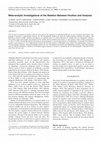Papers by Scott Highhouse
Corporate Reputation Review, 2010
Page 1. Corporate Reputation Review, Vol. 13, No. 1, pp. 3851 © 2010 Macmillan Publishers Ltd., ... more Page 1. Corporate Reputation Review, Vol. 13, No. 1, pp. 3851 © 2010 Macmillan Publishers Ltd., 1363-3589 Corporate Reputation Review Volume 13 Number 1 38 www.palgrave-journals.com/crr/ ABSTRACT Organizational ...
Personnel Assessment and Decisions, 2016
Organizational Behavior and Human Decision Processes, 1998
Public Administration and Development, 2020
Recent research suggesting that people who maximize are less happy than those who satisfice has r... more Recent research suggesting that people who maximize are less happy than those who satisfice has received considerable fanfare. The current study investigates whether this conclusion reflects the construct itself or rather how it is measured. We developed an alternative measure of maximizing tendency that is theory-based, has good psychometric properties, and predicts behavioral outcomes. In contrast to the existing maximization measure, our new measure did not correlate with life (dis)satisfaction, nor with most maladaptive personality and decision-making traits. We conclude that the interpretation of maximizers as unhappy may be due to poor measurement of the construct. We present a more reliable and valid measure for future researchers to use.
APA handbook of testing and assessment in psychology, Vol. 1: Test theory and testing and assessment in industrial and organizational psychology.
International Journal of Selection and Assessment

Industrial and Organizational Psychology
Prestigious journals are widely admired for publishing quality scholarship, yet the primary indic... more Prestigious journals are widely admired for publishing quality scholarship, yet the primary indicators of journal prestige (i.e., impact factors) do not directly assess audience admiration. Moreover, the publication landscape has changed substantially in the last 20 years, with electronic publishing changing the way we consume scientific research. Given that it has been 18 years since the publication of the last journal prestige survey of SIOP members, the authors conducted a new survey and used these results to reflect on changing practices within industrial and organizational (I-O) psychology. SIOP members (n = 557) rated the prestige and relevance of I-O and management journals. Responses were analyzed according to job setting, and were compared to a survey conducted by Zickar and Highhouse (2001) in 2000. There was considerable consistency in prestige ratings across settings (i.e., management department vs. psychology department; academic vs. applied), especially among the top j...

Applied Psychology
Brainteaser interview questions such as "estimate how many windows are in New york" are just one ... more Brainteaser interview questions such as "estimate how many windows are in New york" are just one example of aggressive interviewer behaviour that lacks evidence for validity and is unsettling to job applicants. This research attempts to shed light on the motives behind such behaviour by examining the relation between dark-side traits and the perceived appropriateness of brainteaser interview questions. A representative sample of working adults (n = 736) was presented with a list of interview questions that were either traditional (e.g., "Are you a good listener?"), behavioural (e.g., "Tell me about a time when you failed"), or brainteaser in nature. Results of a multiple regression, controlling for interviewing experience and sex, showed that narcissism and sadism explained the likelihood of using brainteasers in an interview. A subsequent bifactor analysis showed that these dark traits shared a callousness general factor. A second longitudinal study of employed adults with hiring experience demonstrated that perspective-taking partially mediated the relationship between this general factor and the perceived helpfulness and abusiveness of brainteaser interview questions. These results suggest that a callous indifference and a lack of perspective-taking may underlie abusive behaviour in the employment interview. on the hiring side, we found that brainteasers are a complete waste of time… They don't predict anything. They serve primarily to make the interviewer feel smart. (laszlo Bock, senior vice president of people operations at google, quoted in Bryant, 2013)
International Journal of Selection and Assessment
Human‐resource professionals (n = 201) were presented with meta&... more Human‐resource professionals (n = 201) were presented with meta‐analytic validity coefficients associated with unstructured and structured employment interviews. When presented alone, the unstructured interview received a higher effectiveness rating—despite having a smaller validity coefficient—than the structured interview received (d = −.30). When presented together, however, the structured interview was strongly favored (d = .61). The inclusion of the endpoints of the range of operational validities for all selection methods made the presentation‐mode by interview‐structure interaction disappear.
International Journal of Selection and Assessment
ABSTRACT
Personnel Psychology, Apr 1, 2001

Journal of Behavioral Decision Making, 2015
Over 50 years of research on cognitive style has converged on the importance of individual differ... more Over 50 years of research on cognitive style has converged on the importance of individual differences in use of intuition and analysis. This program of research is characterized, however, by two incompatible perspectives about the relation between intuition and analysis. The distinction concerns whether intuition and analysis are opposite poles of a single dimension or whether they are orthogonal constructs. Two studies report meta-analytic investigations of the relation between intuition and analysis. A meta-analysis of the existing research base (k = 80; n = 27 501) showed that intuition and analysis are uncorrelated. A second meta-analysis of combinations of subscales from different cognitive style measures (n = 511) supported the results of the first meta-analysis. Confirmatory factor analysis also supported the existence of two uncorrelated constructs. Overall, the findings support the view that intuition and analysis are independent constructs, rather than opposite ends of a bipolar continuum. In addition, the findings suggest measures of analysis or rationality are not interchangeable.
Personality and Individual Differences, 2014
ABSTRACT

Industrial and Organizational Psychology, 2015
Landers and Behrend (2015) present yet another attempt to limit reviewer and editor reliance on s... more Landers and Behrend (2015) present yet another attempt to limit reviewer and editor reliance on surface characteristics when evaluating the generalizability of study results (see also Campbell, 1986; Dipboye & Flanagan, 1979; Greenberg, 1987; Highhouse, 2009; Highhouse & Gillespie, 2009). Most of the earlier treatments of sample generalizability, however, have focused on the use of college students in (mostly) laboratory studies. Many industrial–organizational (I-O) scholars have experienced the hostility with which studies using students as participants receives. For instance, Jen Gillespie and I observed, “Reviewers and editors commonly assert that students should not be used to study workplace phenomena as though such a declaration requires no further explanation” (Highhouse & Gillespie, 2009, p. 247). The difference this time, however, is that Landers and Behrend (2015) are reacting to dismissals of research using Mechanical Turk (MTurk) workers to make inferences about behavior...

Organizational Behavior and Human Decision Processes, 1996
We examined determinants of subjective framing other than semantic manipulation. Participants in ... more We examined determinants of subjective framing other than semantic manipulation. Participants in the first experiment (n = 176) read several business threats or opportunities, prior to describing a strategic issue. Results revealed a contrast effect, where those exposed to unequivocal opportunities framed an equivocal issue as a threat, whereas those exposed to unequivocal threats did not view the same issue as threatening. A second experiment (n = 185) replicated the contrast effect using only one context manipulation (i.e., threat or opportunity business scenario), and alternative modes of presentation (i.e., serial vs simultaneous). A third experiment (n = 72) showed that the contrast effects extended beyond simple perceptions to actual intentions and behaviors. We conclude that the narrowing of one's frame for a strategic issue may result in a restricted range of alternatives considered and suboptimal responses.

PsycEXTRA Dataset, 2007
Some people like the name industrial-organizational (I-O) psychology because it sounds profession... more Some people like the name industrial-organizational (I-O) psychology because it sounds professional. Others like that it is descriptive and reflects an evolved interest in both individual and organizational processes. Many, however, find the title clunky, confusing, and antiquated. Some of these people would like the name shortened to simply "organizational psychology" or "business psychology." These folks believe that the shorter title is more advantageous for communicating to managers that we can provide a competitive advantage to organizations. Some would like to see it changed to "work psychology." These folks believe that this title would communicate to lay people, reporters, and funding agencies that we study the psychology of the workplace broadly defined. Still others would like to see the name changed to "work and organizational psychology" to take advantage of all of these benefits and to provide some consistency with our European cousins. 1 As I point out in this essay, we have long been struggling with the issue of what to call ourselves. Name Change Attempts

Handbook of Psychology, Second Edition, 2012
CONCLUSION 12 REFERENCES 12 As we write this chapter, the field of industrialorganizational psych... more CONCLUSION 12 REFERENCES 12 As we write this chapter, the field of industrialorganizational psychology in the United States has survived its third attempt at a name change. To provide a little perspective, the moniker industrial psychology became popular after World War I, and described a field that was characterized by ability testing and vocational assessment (Koppes, 2003). The current label, industrialorganizational (I-O) psychology, was made official in 1973. The addition of organizational reflected the growing influence of social psychologists and organizational development consultants, as well as the intellectual and social milieu of the period (see Highhouse, 2007). The change to I-O psychology was more of a compromise than a solution-which may have succeeded only to the extent that everyone was equally dissatisfied. The first attempt to change this clunky label, therefore, occurred in 1976. Popular alternatives at the time were personnel psychology, business psychology, and psychology of work. The leading contender, however, was organizational psychology because, according to then-future APA Division 14 president Arthur MacKinney, "all of the Division's work is grounded in organizational contexts" (MacKinney 1976, p. 2). The issue stalled before ever making it











Uploads
Papers by Scott Highhouse